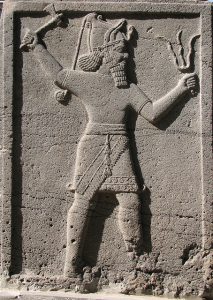Today I want to tie up a couple of loose ends with reference to Wayne Horowitz’s Mesopotamian Cosmic Geography as it relates to the Hebrew understanding of the world that appears in Genesis 1 and elsewhere in the Bible. The main themes, the non-existence of a heavenly ocean, and the non-existence of a solid vaulted heaven, in “ANE cosmology” I dealt with here and here.
Simplifying heaven and earth
The first of these linked articles described a “basic” Mesopotamian geography of three heavens and three earths, but actually Horowitz points out in his book that the evidence for this comes from only a small range of texts, with most of the remainder actually suggesting a simpler system that more closely resembles that of the Bible. This can be summarised in a few direct quotations:
Heaven is the upper of the two halves of the universe. In ancient Mesopotamia, as in the Judeo-Christian tradition, the heavens include both visible areas, where the stars, Sun, Moon, and planets are seen, and higher regions above the sky, where gods of heaven dwell. Only the lists of KAR 307 and AO 8196 and Enuma Elish provide clear evidence that the heavens consist of the sky and more than one level above the sky… The area between the earth’s surface and the stars is not listed in KAR 307 or AO 8196 but is part of the heavens in other texts. For instance, numerous passages speak of birds, clouds, and winds in the heavens (See CAD S/I 345-47), so the region of the universe we call the “atmosphere” or “sky” was clearly part of heaven in ancient Mesopotamia…
Outside KAR 307, AO 8196, and Enuma Elish (and perhaps the Sumerian incantations), the heavens can be divided into two regions only: (1) the sky and (2) the region above the sky. In Sumerian literary texts, a region of heaven above the sky belonging to An is called an.sa, and a term an.un.na High Heaven’ occurs in both Inanna and Sukkaletuda and the Kassite period Sumerian language work The Duties and Powers of the Gods. In Akkadian texts from the Middle Assyrian period onward, heavens above the sky are called “The Heaven of Anu”.
Much of the debate in biblical studies about the solid raqia named shemayin (the heavens) revolves around whether the word must be understood as a solid vault above the realm of the birds, clouds and winds (based on the idea that the Babylonian heavens are solid and that raqia‘s etymology demands it) or whether raqia should instead be translated as an “expanse” which itself includes that lower region. The passages quoted above show that a comparable ambiguity exists in the Mesopotamian view of the “lower heaven”: sometimes it is seen as a space below heaven, and at others as the lower part of heaven.
Phenomenologically this ambiguity is exactly the same in the English concept of “sky” – we’ll think of birds flying in the sky, or of flying a kite in the sky, but not of being in the sky if we work in an office of a similar height. Likewise, the first “skyscraper” scraped the heavens at a mere 180 feet – less than a third of the elevation of the hill on which my house stands firmly anchored to the earth, with the sky far above.
You’ll notice also the comparable, and perhaps rather fluid, division between “the heavens” and “the highest heavens”, the dwelling of Deity, in both Mesopotamian and Hebrew thought. It’s a fluid division in that, in the cuneiform texts, the astronomical bodies enter the heavens through gates and seem, therefore, to share space with the gods, even though elsewhere the stars are described as inscribed upon the lower surface of the sky. And in the Bible, it would appear on close examination that the “lights” of day 4 occupy the realm of darkness (in which light appears on Day 1) in which the spirit or breath of God is said to be brooding in the beginning. More on that at the end.
Rain
I mentioned last time how the Babylonians considered that their word for the heavens, etymologically related to Hebrew shemayim, derived from the waters from which the heavens were made. That brings us to the question of rain, from the same root in Akkadian, which in modern biblical studies has come to be regarded as being believed, by the Hebrews, to come from God’s opening “floodgates” to let in the vast cosmic ocean.
There are, in fact, many biblical passages that show that the Hebrews knew full well that rain comes from clouds, which hold large amounts of water and which rise or distill in order to be formed, rather than in some unspecified way clumping beneath the supposed floodgates in the firmament. Once such clouds as sources of rain are recognised in the texts, the cosmic ocean becomes a rather unnecessary entity (which is good, since as I’ve already shown it has no existence in either cosmology). But there are parallel scattered references to the source of rain in the Babylonian literature too.
I mentioned last time the Babylonian description of the lower heavens as made of jasper, because of its variable colour. I also mentioned how hard it is to say whether the stone was considered to be literal or not. Horowitz says:
Descriptions of two varieties of jasper in Abnu-sikinsu explain why the Lower Heavens are identified with jasper in Mesopotamia…:
The stone whose appearance is like the clear heavens is named jasper.
The stone whose appearance is like a rain cloud is named jasper.
The thing to notice here is the simple, but important, observation that there is such a thing as a “rain cloud”, for jasper to resemble. The writer clearly knew that rain comes from clouds. This is even seen in the Mesopotamian Flood narratives, which don’t use the metaphor of “windows of heaven” like Genesis. From Atrahasis:
The outlook of the weather changed.
Adad began to roar in the clouds.
The god they heard, his clamor.
He brought pitch to seal his door.
By the time he had bolted his door,
Adad was roaring in the clouds.
The winds were furious as he set forth…
The storm God does his destructive work from the storm clouds. And from the Gilgamesh version:
Just as dawn began to glow
there arose from the horizon a black cloud.
Adad rumbled inside of it,
before him went Shullat and Hanish,
heralds going over mountain and land.
Erragal pulled out the mooring poles,
forth went Ninurta and made the dikes overflow.
The Anunnaki lifted up the torches,
setting the land ablaze with their flare.
Once more, Adad is controlling his storm from inside a black cloud – but in this case, just like the cloud seen by Elijah’s servant on Mount Carmel, this cloud arises from the horizon, which as we saw before is the place where earth approaches heaven: the cloud even for the storm in the Great Flood ultimately comes from the earth, not from a heavenly ocean.
There are some poetic Babylonian descriptions of the origin of rain that are not found in the Bible, but cast light on its own descriptions. For instance,
The phenomenon of rainfall is explained in different ways. In the Lamastu incantation 4R 2 58 // PBS 1/2 ) 13, dew is connected in some way with the stars.
A more exotic idea is this:
In Sumerian texts, rain issues out of cosmic teats called ubur.an.na ‘teat of heaven’, which serve as rain ducts in the sky. In a royal hymn to Rim-Sin, the opening of these ducts results in rainfall:
ubur.an.sud.áḡa ḡál ḫu.mu.ra.ab.tag4 segx(IM.A) .an.na ḫu.mu.ra.ab. šeg
UET 6/1 102:23 (Steib Ie Rim-Sin 6)
May he open the teat of the elmešu heavens, may he make the rain of heaven rain down.
Because sud.áḡa = elmešu (see CAD E 107), the surface of the heavens appears to be made of elmesu-stone, and rain water may be stored in reservoirs above.
There are similar passages, whose translation suggests the figurative implication of the metaphor:
May he open the “teat of heaven” for him, may he … the harvest [ …
In this last passage, the opening of the “teat of heaven” apparently provides rain for the harvest. Thus, the “teat of heaven” seems to provide life-sustaining rain waters, just as human and animal teats provide mothers milk.
But the poetic nature of this metaphor is shown where it is paralleled with clouds as the source of rain:
șer-re-et šamee rap-šu-ti li-ip-pé-ta-šú er-pé-tu zu-un-na li!-[ …]
5R 33 vii 16-21 (Agum II)
Let the breasts of the broad heavens be opened for him, let the clouds. [ … ] the rain.
So like the biblical “windows of heaven”, or the “storehouses” for rain, hail or snow, it seems very likely that the Babylonian “teats of heaven” are nothing more than a colourful description of clouds.
Light before the sun
 One final point from Horowitz relates to my previous suggestion that, in Genesis, the light may appear on Day 1 before the sun on Day 4 simply because phenomenologically, the ancient Hebrews made no direct connection between the blue daylit sky, and the sun as the ultimate source of its glow. I first suggested this in my Letting the air out of Genesis 1.
One final point from Horowitz relates to my previous suggestion that, in Genesis, the light may appear on Day 1 before the sun on Day 4 simply because phenomenologically, the ancient Hebrews made no direct connection between the blue daylit sky, and the sun as the ultimate source of its glow. I first suggested this in my Letting the air out of Genesis 1.
Since I posted that, I’ve become aware that this idea was known somewhat later in the pre-philosophical Greek world. There, the upper, luminous air of heaven was termed aither (as opposed to the aer of cloud and mist and the “ordinary” air which originally, according to Plato, had no name), having this name for the very reason that it was a source of light:
…from Greek aithēr ‘upper air’, from the base of aithein ‘burn, shine’.
Horowitz shows that this idea had currency in the cuneiform world, too, via the use of the word “si” as a synonymn for heaven. He writes:
Another example of si = šamȗ is found in Aa 111/4 171:
si = nu-ú-rum ‘light’
si = na-ma-rum ‘to shine’
si = na-pa-ḫu ‘to kindle’
si = šámu-u ‘heaven’
(MSL 14 341:168-7])Here si may be a name for heaven because si has a general meaning ‘light’. According to NBC 11108 (see p. 139), the heavens glow with their own light independent of the luminaries in the sky.
But though this makes the creation of light before the sun in Genesis appear more rational, does it not show scientific error? I suggest that is only so if one tries to make it science by trying to accommodate Genesis to something like the Day-Age Theory. For we already knew that, according to current science, the ocean did not precede the dry land on earth, nor the earth itself the stars, let alone the sun. But if the Creation narrative is understood thematically, as in the Framework hypothesis, especially when it functions as a temple-inauguration narrative about the creation, largely by acts of separation, of more and less sacred space, then it all makes perfect sense
Mesopotamian cosmic geography and the Genesis creation
The highest “primaeval” region – the “darkness” upon the face of the waters, in which God’s spirit broods, is divided by newly-created light on Day 1 into day and night, which are thus rendered useful. This region becomes populated on Day 3 by the heavenly bodies, marking off and governing them, and acting as both light and signs for mankind and, arguably, constituing the “highest heaven” in which God places his Name (though being too small to contain him, as Solomon declares later).
The second “primaeval” region is the deep – tehom, which is divided by the heavens, shemayim on Day 2 into upper and lower waters. The lower waters become potentially useful to man thereby. In the “heavenly ocean” scheme the upper waters are, for the most part, useless apart from a tiny proportion providing rain whilst the rest has to be kept out. In my scheme there is no heavenly ocean, and the upper waters are the clouds providing fresh-water in rainfall and so on for mankind. This aspect of the providential utility to mankind of every element in Genesis 1 is pointed out by Vern Poythress, and is a powerful argument against the cosmic ocean idea. As I have pointed out before, this act of creation on Day 2 has its exact counterpart on Day 5 in the creation of fish etc to populate the lower waters, and birds to populate the upper waters (ie clouds) and the shemayim considered more generally. The existence of a lifeless cosmic ocean would destroy this symmetry, of course.
The lowest “primaeval” region is the “unformed land” beneath the waters, from which it is separated on Day 3 to make the useful seas and the dry land. The latter is populated on Day 6 by the animals, of course, but lastly also by man as its ruler. This climax is, I venture to suggest, the symmetrical antithesis to God’s rulership from the “highest heaven” at the start of the story, as he broods above what he has not yet organised. Finally the seventh-day sabbath unites these two “centres of government” in a world that is “very good”.
We end up, then, with God in, and reigning from, the heavenly holy of holies, dwelling in “unapproachable light” or “thick darkness” according to the most appropriate metaphor for the occasion; whilst mankind, ruling and subduing the land, represents the worshippers in the court of the temple, as well as its only authorised image. The lower heavens, in between, represent the holy space of the sanctuary which one may sometimes traverse to meet with God, yet separated from him by the curtain of the upper waters as clouds habitually hide God in the Scriptures.
The seas represent, symbolically at least, the remains of the unformed and vaguely threatening primordial creation, yet also the ritually cleansing waters of the “sea” in Solomon’s temple.
All of this fits with the phenomenological reality of that time discernible behind the Mesopotamian cosmic geography described by Horowitz in his book. It demonstrates that Israel did indeed share the general features of the ANE understanding of the physical world – but also that that world has little or nothing to do with the usual representations and descriptions in other recent literature.
Theologically, the Hebrew account is something else again!



